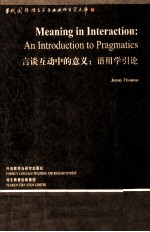图书介绍
言谈互动中的意义 语用学引论 英文PDF|Epub|txt|kindle电子书版本网盘下载

- (英)托马斯著 著
- 出版社: 北京:外语教学与研究出版社
- ISBN:9787513500609
- 出版时间:2010
- 标注页数:224页
- 文件大小:10MB
- 文件页数:254页
- 主题词:语用学-研究-英文
PDF下载
下载说明
言谈互动中的意义 语用学引论 英文PDF格式电子书版下载
下载的文件为RAR压缩包。需要使用解压软件进行解压得到PDF格式图书。建议使用BT下载工具Free Download Manager进行下载,简称FDM(免费,没有广告,支持多平台)。本站资源全部打包为BT种子。所以需要使用专业的BT下载软件进行下载。如BitComet qBittorrent uTorrent等BT下载工具。迅雷目前由于本站不是热门资源。不推荐使用!后期资源热门了。安装了迅雷也可以迅雷进行下载!
(文件页数 要大于 标注页数,上中下等多册电子书除外)
注意:本站所有压缩包均有解压码: 点击下载压缩包解压工具
图书目录
1 What is pragmatics?1
1.1 Introduction1
1.2 Defining pragmatics1
1.3 From abstract meaning to contextual meaning2
1.3.1 Assigning sense in context5
1.3.2 Assigning reference in context8
1.3.3 Structural ambiguity12
1.3.4 Interaction of sense,reference and structure12
1.3.5 Ambiguity and intentionality14
1.4 Utterance meaning:the first level of speaker meaning16
1.4.1 Importance of utterance meaning16
1.5 Force:the second level of speaker meaning18
1.5.1 Understanding both utterance meaning and force18
1.5.2 Understanding utterance meaning but not force19
1.5.3 Understanding force but not utterance meaning19
1.5.4 Understanding neither utterance meaning nor force20
1.5.5 Interrelationship of utterance meaning and force21
1.6 Definitions ofpragmatics(revisited)21
1.6.1 Speaker meaning21
1.6.2 Utterance interpretation22
1.6.3 Pragmatics:meaning in interaction22
1.7 Summary23
2 Speech acts28
2.1 J.L.Austin28
2.2 Ordinary language philosophy29
2.3 Logical positivism and truth conditional semantics29
2.4 The performative hypothesis32
2.4.1 Metalinguistic performatives33
2.4.2 Ritual pefformatives36
2.4.2.1 Felicity conditions37
2.4.2.2 Explicit reference to felicity conditions40
2.4.3 Collaborative performatives40
2.4.4 Group performatives41
2.4.5 Overlap of categories42
2.4.6 Cross-cultural differences in use of performatives43
2.4.7 Collapse of Austin's performative hypothesis44
2.4.7.1 The grammatical distinctiveness of performatives44
2.4.7.2 Do performatives always perform actions?45
2.4.7.3 How to do things without performative verbs46
2.4.8 Explicit and implicit performatives47
2.5 Utterances as actions49
2.5.1 Locution,illocution,perlocution49
2.5.2 Speech acts51
2.6 Conclusion51
3 Conversational implicature55
3.1 Introduction55
3.2 H.P.Grice56
3.3 Implicature57
3.3.1 Conventional implicature57
3.3.2 Conversational implicature58
3.3.3 Implicature and inference58
3.4 The Cooperative Principle61
3.5 The four conversational maxims63
3.5.1 Observing the maxims64
3.5.2 Non-observance of the maxims64
3.6 Flouting a maxim65
3.6.1 Flouts necessitated by a clash between maxims65
3.6.2 Flouts which exploit a maxim67
3.6.2.1 Flouts exploiting the maxim of Quality67
3.6.2.2 Flouts exploiting the maxim of Quantity69
3.6.2.3 Flouts exploiting the maxim of Relation70
3.6.2.4 Flouts exploiting the maxim of Manner71
3.7 Other categories of non-observance of the conversational maxims72
3.7.1 Violating a maxim72
3.7.2 Infringing a maxim74
3.7.3 Opting out of a maxim74
3.7.4 Suspending a maxim76
3.8 Testing for implicature78
3.8.1 Non-detachability and non-conventionality78
3.8.2 Implicature changes80
3.8.3 Calculability82
3.8.4 Defeasibility82
3.9 Conclusion84
4 Approaches to pragmatics87
4.1 Introduction87
4.2 Problems with Grice's theory87
4.2.1 When is non-observance intentional?88
4.2.2 Distinguishing between types of non-observance90
4.2.3 Different nature of maxims91
4.2.4 Maxims may overlap91
4.2.5 Problems of calculability92
4.3 Grice's informal approach93
4.4 J.R.Searle93
4.4.1 Indirect speech acts93
4.4.2 Searle's conditions for speech acts94
4.4.2.1 Distinguishing speech acts96
4.4.2.2 Plugging the gaps in Searle's rules98
4.4.2.3 The speech act of apologizing:a case study99
4.4.2.4 Over-generality of rules102
4.4.2.5 The speech act of warning:a case study103
4.5 Searle's formal approach to the categorization of speech acts105
4.6 Rules versus principles107
4.6.1 Rules are all or nothing,principles are more or less108
4.6.2 Rules are exclusive,principles can co-occur108
4.6.3 Rules are constitutive,principles are regulative109
4.6.4 Rules are definite,principles are probabilistic110
4.6.5 Rules are conventional,principles are motivated111
4.7 Conclusion114
5 Pragmatics and indirectness119
5.1 Introduction119
5.2 Pragmatics and indirectness119
5.2.1 Intentional indirectness120
5.2.2 Indirectness is costly and risky120
5.2.3 Assumption of rationality121
5.2.4 The principle of expressibility122
5.2.5 Indirectness—an illustration123
5.3 How do we know how indirect to be?124
5.3.1 Power124
5.3.2 Social distance128
5.3.3 Size of imposition130
5.3.4 Rights and obligations131
5.3.5 The negotiation of pragmatic parameters131
5.4 Measuring indirectness133
5.4.1 The role of context in interpreting indirectness136
5.4.2 The role of belief in interpreting indirectness137
5.4.3 Background knowledge and interpreting indirectness138
5.4.4 The role of co-text in interpreting indirectness138
5.4.5 Goals and the interpretation of indirectness139
5.5 Why use indirectness?142
5.5.1 Interestingness143
5.5.2 Increasing the force of one's message144
5.5.3 Competing goals145
5.6 Conclusion146
6 Theories of politeness149
6.1 Introduction149
6.2 Delimiting the concept of politeness149
6.2.1 Politeness as a real-world goal150
6.2.2 Deference versus politeness150
6.2.3 Register154
6.2.4 Politeness as an utterance level phenomenon155
6.2.5 Politeness as a pragmatic phenomenon157
6.3 Politeness explained in terms of principles and maxims158
6.3.1 Ambivalence and politeness158
6.3.2 Pragmatic principles159
6.3.2.1 The Tact maxim160
6.3.2.2 The Generosity maxim162
6.3.2.3 The Approbation maxim162
6.3.2.4 The Modesty maxim163
6.3.2.5 The Agreement maxim165
6.3.2.6 The Pollyanna Principle166
6.3.3 Problems with Leech's approach167
6.4 Politeness and the management of face168
6.4.1 Face-threatening acts169
6.4.1.1 Superstrategies for performing face-threatening acts169
6.4.1.2 Performing an FTA without any redress(bald-on-record)170
6.4.1.3 Performing an FTA with redress(positive politeness)171
6.4.1.4 Performing an FTA with redress(negative politeness)172
6.4.1.5 Performing an FTA using off-record politeness173
6.4.1.6 Do not perform FTA174
6.4.2 Criticisms of Brown and Levinson176
6.5 Politeness viewed as a conversational contract176
6.6 Politeness measured along pragmatic scales177
6.7 Conclusion178
7 The construction of meaning183
7.1 Introduction183
7.2 How does pragrnatics fit into linguistics?184
7.3 Pragmatics versus sociolinguistics185
7.3.1 Overlap between pragmatics and sociolinguistics186
7.4 Activity types versus speech events187
7.5 The construction of meaning195
7.5.1 Pragmatic ambivalence195
7.5.2 The collaborative nature of speech acts196
7.5.3 The negotiability of force198
7.5.4 Preparing the ground for a speech act199
7.5.5 Successive utterances in situated discourse201
7.5.6 Discoursal ambivalence202
7.5.7 Dynamic pragmatics203
7.6 What counts as evidence in pragmatics?204
7.6.1 Perlocutionary effect205
7.6.2 Explicit commentary by speaker205
7.6.3 Explicit commentary by others206
7.6.4 Co-text(subsequent discourse)207
7.7 Conclusion208
References211
Index of Names219
Index of Subjects221